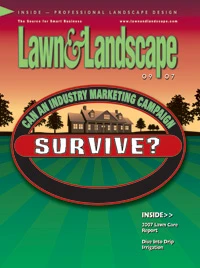The warm, candle-like glow of clear, incandescent lights have for years been the most popular holiday lighting selection, holiday decorators say. Consumers like the traditional look of all white lights, which decorators often dress up with wreaths and greenery. While white lights remain popular, the trend that’s giving this monochromatic look a run for its money, however, is the advent of LED lights. “LEDs are increasingly popular because of the green movement,” says Travis Freeman, president of Brite Ideas Decorating, an Omaha, Neb.-based network of holiday decorating product distributors. “The vibrancy of the colors also provide a new look. It’s really the next big thing.”
The movement toward LED bulbs, or light-emitting diode bulbs, is a trend in itself, but it also may be in part driving another trend: consumers’ willingness to experiment with colorful displays rather than all white ones.
BENEFITS OF LEDS. LED bulbs offer an array of benefits that their incandescent counterparts don’t. The No. 1 attraction is energy savings – LEDs typically consume 90 percent less energy than incandescent lights. The U.S. Department of Energy calculated in 2003 that the potential energy savings of a complete shift in the holiday lighting market from incandescent bulbs to LEDs is approximately 21.9 trillion Btu – the equivalent of the annual amount of electricity consumed by more than 600,000 households, according to the Energy Information Administration.
One concern for holiday lighting customers, though, is the initial investment, as LED lighting products can be up to four times more expensive than traditional lights. However, the lifetime cost of LED bulbs is cheaper than incandescent bulbs when you consider the electric bill savings and much longer lifespan of LEDs, which are rated at 75,000 hours vs. 3,000 hours for typical incandescents, says Brandon Stephens, director of marketing for Christmas Décor, an Omaha, Neb.-based holiday decorating franchisor.
Even though LEDs are a greater initial investment than incandescents, upselling customers to LEDs should be fairly easy because holiday lighting services are typically geared toward homeowners with disposable incomes.
The average cost of a holiday lighting installation is between $1,500 and $2,600, according to several national suppliers. LED installations are typically 25 percent more, or around $3,300, Freeman says. “LEDs are more efficient energy-wise, and we deal with a pretty affluent customer who’s conscious of that type of thing,” Stephens says. “It makes sense for them long-term.”
But that’s not to say all customers are going to jump on the LED bandwagon. “It’s been a little more difficult to sell LEDs than we anticipated,” says Krisjan Berzins, vice president of Kingstowne Lawn & Landscape in Lorton, Va. His company became a holiday lighting distributor and service provider in 2000. “We’ve taken an already expensive service and made it that much more expensive,” he says of LEDs. Berzins and other contractors expect more customers to migrate to LEDs as the prices come down and their existing lights need to be replaced.
Installing LED lights is advantageous for a contractor, too. LEDs use less energy per bulb, thus less energy per installation, so more light strings can be connected end to end, which means fewer extension cords are required. LEDs save contractors on labor, as well, because of a reduction in service calls, says Brad Finkle, owner of Creative Decorating, an Omaha, Neb.-based holiday decorator and supplier. “With traditional lights, you get bulbs burning out in a year or two and a lot of service calls going back and forth to replace lights,” Finkle says. “LEDs last 10 times as long, so you save on repairs and labor there.”
Some customers have resisted moving to LEDs because they don’t like the look. People perceive them to have a bluish tint, as compared to the yellowish glow they’re used to with incandescents. But manufacturers say LEDs’ quality and crispness have improved greatly since the first generation was introduced a number of years ago and LEDs of today look more like incandescents. “It’s personal preference,” says Scott Heese, president and founder of Holiday Bright Lights, an Omaha, Neb.-based holiday lighting membership system and manufacturer. “A lot of customers still request the incandescent lights because they prefer the look, but a lot of them go with LEDs because they’re trying to find something unique and different.”
TRENDWATCH. With LEDs, clients are more inclined to use color, Heese says. “While the majority of sales – at least 80 percent – are still clear lights, color is becoming more popular because the LEDs are more brilliant.”
Paul Sessel agrees. “White lights dominate the marketplace, but I’m seeing more colors being used with LED lights because the colors are so rich and vibrant,” says the owner of Creative Displays, an Overland Park, Kan.-based holiday lighting distributor. The color blue is one example. Incandescent blues can be difficult to see, Sessel says. “But the LED blues really pop out.”
Though LEDs have been slow to catch on among Billy Leavell’s clients, the trend toward using color is strong.
“When we first started holiday lighting four years ago, the trend was pretty much all white lights,” says the president of Turf Managers, Nashville, Tenn. “We’re seeing that customers definitely want some more color in their displays now. That’s the true part of this season – having bright festive lights like when we were kids.”

Explore the September 2007 Issue
Check out more from this issue and find your next story to read.
Latest from Lawn & Landscape
- ExperiGreen, Turf Masters Brands merge
- EquipmentShare cuts ribbon on new Maryland branch
- Strathmore acquires Royal Tree Service in Montreal
- In a new direction
- The December issue is now live
- Ignite Attachments debuts 80-inch, severe-duty bucket
- EquipmentShare breaks ground on Roswell branch
- NaturaLawn of America adds Schwartz, Medd to operations team





